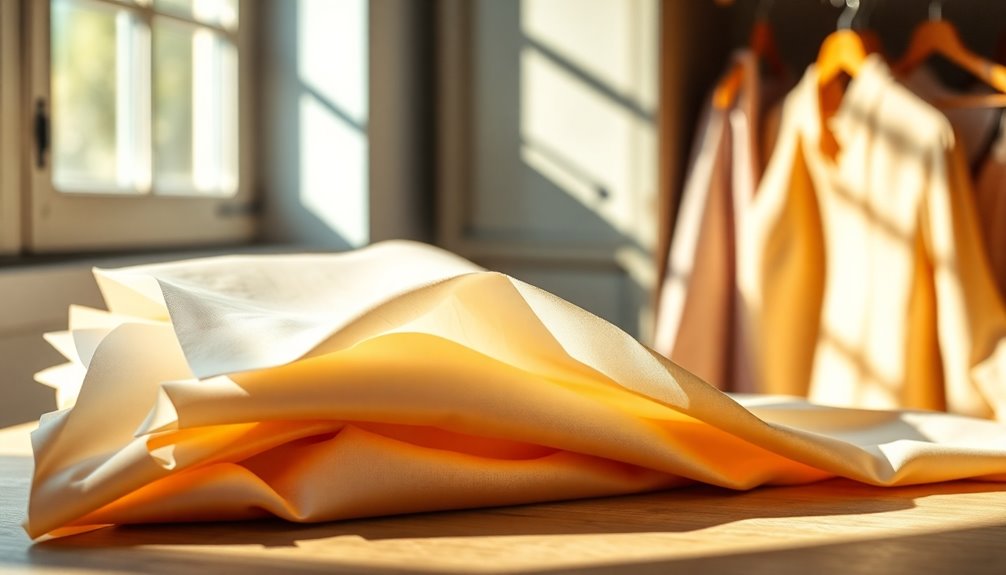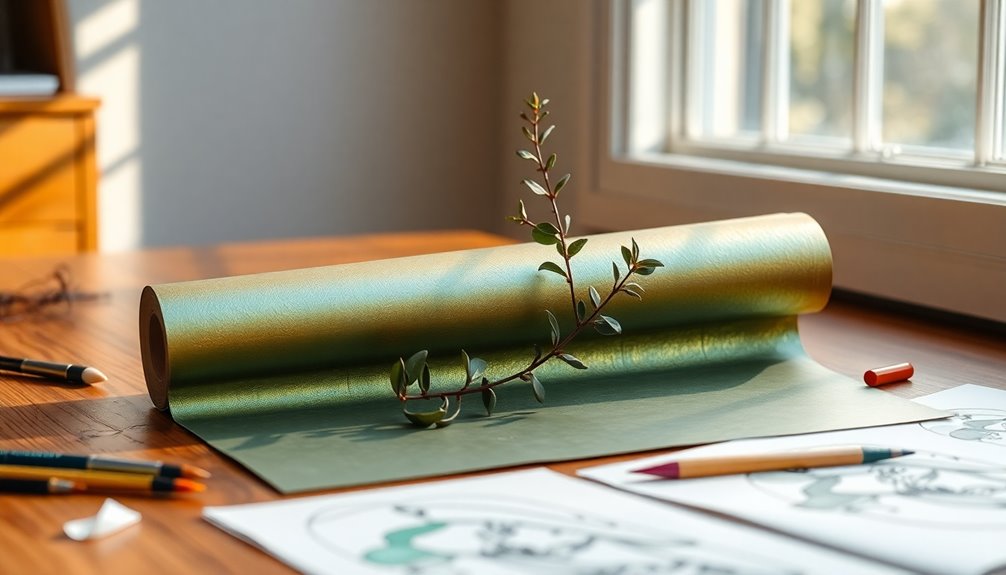Acid-free tissue paper is your hidden hero for safe clothing storage. Its neutral pH protects your fine garments from color transfer and harmful chemical reactions. You can layer it between delicate pieces to prevent creases and minimize friction while allowing fabrics to breathe, reducing moisture damage. This is particularly important for heirlooms like wedding gowns and vintage dresses. While it may cost a bit more than regular tissue paper, its benefits far outweigh any concerns. You'll discover more essential tips for preserving your garments and keeping them in pristine condition along the way.
Key Takeaways
- Acid-free tissue paper maintains a neutral pH, safeguarding delicate fabrics from harmful chemical reactions and color transfer during storage.
- It prevents yellowing of textiles over time, preserving the original color and integrity of garments such as silks and wools.
- Layering acid-free tissue paper between clothing items minimizes friction, protecting against creases and maintaining the shape of delicate garments.
- The lightweight texture allows fabrics to breathe, reducing moisture build-up and the risk of mildew during long-term storage.
- Though more costly than regular tissue paper, the long-term preservation benefits for heirlooms like wedding dresses make it invaluable.
Essential for Heirloom Preservation
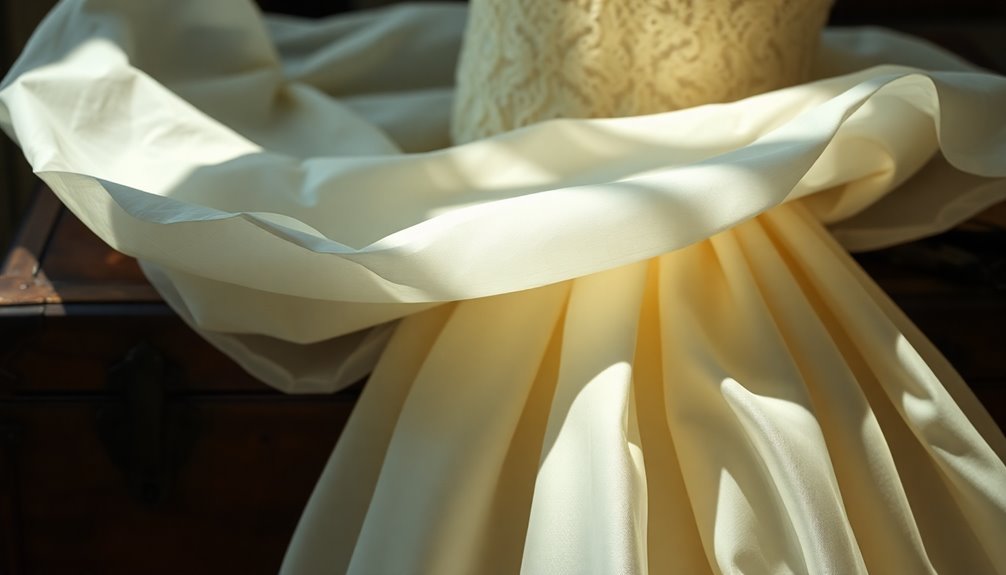
When it comes to preserving your cherished heirlooms, using acid-free tissue paper is a must. This specially processed paper has a neutral pH of 7, making it safe for your fine garments. It protects against color transfer and harmful chemical reactions that can occur with traditional materials. By incorporating acid-free tissue paper into your clothing storage routine, you can safeguard items like wedding gowns and vintage dresses from deterioration during long-term storage.
Layering acid-free tissue paper between folded garments is an effective technique. This practice minimizes fiber breakage and prevents unsightly creases that could ruin the appearance of your treasured pieces. Additionally, the paper allows heirloom textiles to breathe, which is crucial for avoiding moisture damage.
When wrapping and interleaving your garments in storage boxes, acid-free tissue paper is essential. Conservators highly recommend it for maintaining the pristine condition of heirlooms. By taking these simple steps, you ensure that your delicate fabrics remain intact, ready to be cherished for generations to come. Preserve your legacy with this invaluable tool in clothing storage.
Acid-Free Prevents Yellowing Fabrics
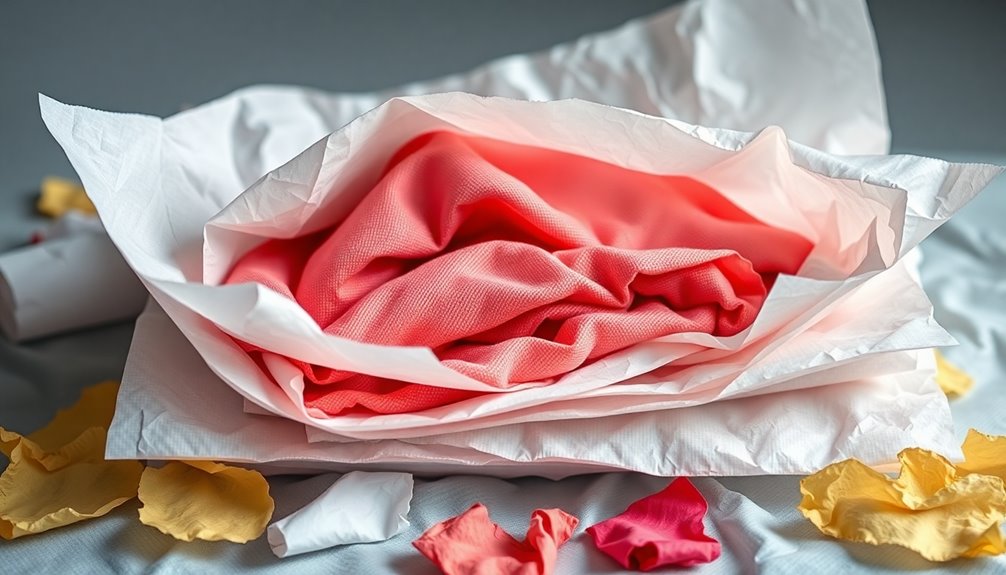
Using acid-free tissue paper is crucial for preventing the yellowing of fabrics over time. This specialized paper maintains a neutral pH level of 7, effectively safeguarding your textiles against deterioration. Unlike regular tissue paper, which can contain harmful acids, sulfur, and lignin, acid-free tissue paper helps keep your garments vibrant and intact.
When storing your precious fabrics, remember that regular tissue can release dyes and chemicals that lead to unwanted yellowing. In contrast, acid-free options ensure a safe environment for long-term storage. By using acid-free tissue paper, you allow your garments to breathe more freely, which reduces the risk of color transfer and helps preserve their original hues.
This is especially important for delicate fabrics like silks and wools, which are prone to discoloration. By choosing acid-free tissue paper, you're taking a proactive step to protect your clothing, ensuring it remains in pristine condition without the dreaded yellowing that can come from improper storage methods. Keeping your fabrics safe is not just about protection; it's about maintaining their beauty for years to come.
Layer Between Garments

Placing acid-free tissue paper between your garments creates a vital protective layer that prevents color transfer and dye bleeding. Its pH neutral properties ensure that your clothing remains safe during storage, especially when dealing with multi-colored items. By inserting sheets of acid-free tissue paper, you significantly reduce the risk of damage caused by fabric reactions and the deterioration often associated with regular tissue paper.
Moreover, the lightweight and smooth texture of acid-free tissue paper minimizes friction, protecting delicate fabrics from unwanted creases and wrinkles. This is especially important for garments that you plan to store for an extended period. Using layers of acid-free tissue paper not only keeps your garments safe but also allows them to breathe. This reduces the risk of moisture build-up and mildew, which can be detrimental during long-term storage.
You'll also find that acid-free tissue paper can be easily folded and shaped to fit snugly between your garments, ensuring that the integrity of each clothing item is preserved. So, make sure to include this essential layer in your storage routine for optimal protection.
Pros and Cons of Preservation
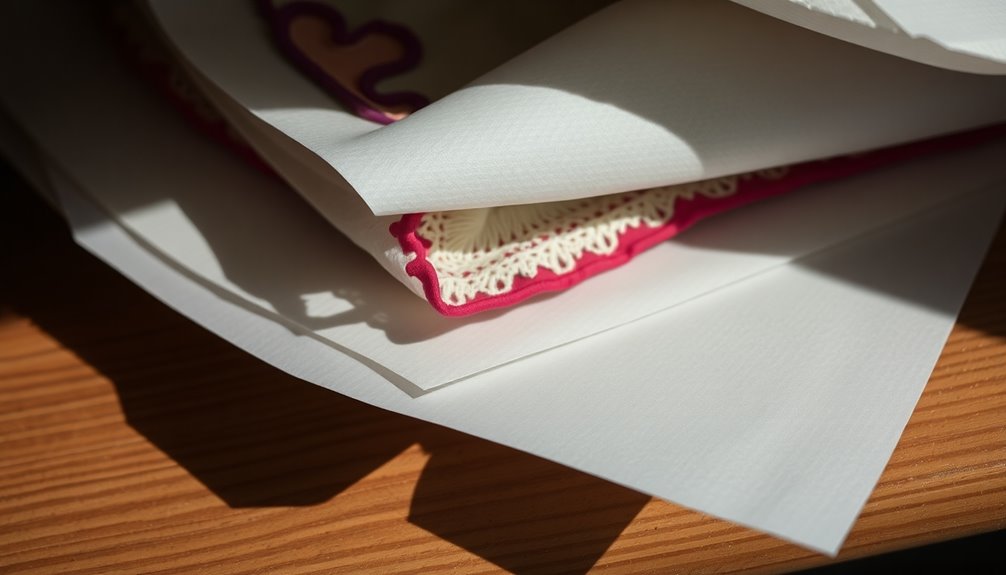
Preserving your clothing with acid-free tissue paper offers significant benefits, but it's essential to weigh the pros and cons. On the plus side, acid-free tissue paper is pH neutral, preventing dye transfer and reactions that can damage your garments over time. Unlike regular tissue paper, which can deteriorate and harm fabrics through acid transfer, acid-free options ensure long-term protection, especially for delicate materials like silk and wool. This choice also allows your garments to breathe, reducing the risk of moisture damage and maintaining fabric integrity during storage.
However, there are some downsides to consider. Acid-free tissue paper can be more expensive than regular tissue paper, which might be a concern if you're on a tight budget. Additionally, if you don't use it correctly, such as not interleaving multi-colored garments properly, you might still face issues with color bleeding. Lastly, while it provides excellent preservation, it requires careful handling—improper storage can negate its benefits.
Wedding Dress Preservation Success
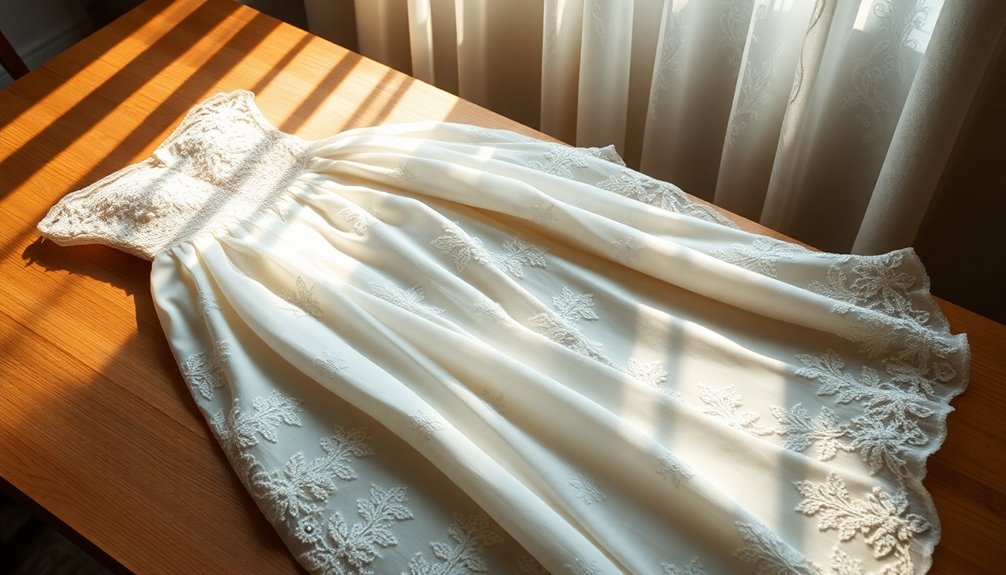
When it comes to wedding dress preservation, acid-free tissue paper plays a crucial role in ensuring your gown remains beautiful for years to come. This specialized paper prevents color transfer and protects delicate fabrics from deterioration over time. By placing layers of acid-free tissue paper between the folds of your wedding dress, you help maintain its shape and prevent unsightly creases.
The pH-neutral properties of acid-free tissue paper ensure it won't react with your gown's fabric, safeguarding intricate embellishments and delicate materials. Many wedding dress preservation kits include this essential component, emphasizing its importance for protecting these cherished garments. Long-term storage with acid-free tissue paper allows your wedding dress to breathe, reducing the risk of mildew while maintaining its captivating beauty for future generations.
Moth Prevention and Fabric Care
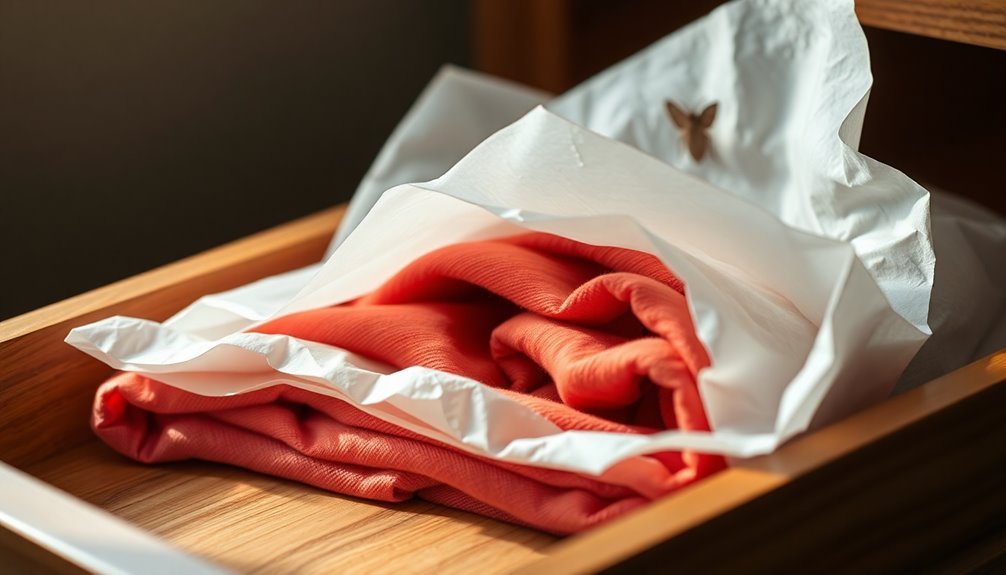
To keep your clothing safe from pesky moths, using acid-free tissue paper is a smart choice for fabric care during storage. This specialized paper allows your delicate fabrics to breathe, which helps deter moths and prevent infestations by minimizing moisture and promoting air circulation. When you wrap your garments in acid-free tissue paper, you create a protective barrier that shields them from moth larvae and other pests during long-term storage.
Regular tissue paper can contain harmful dyes that deteriorate over time, attracting unwanted pests. In contrast, acid-free tissue paper is designed to resist degradation, ensuring your fabrics stay safe. By placing acid-free tissue paper between folded garments, you reduce friction and potential damage, making it less likely for moths to be drawn to your clothing.
Additionally, the pH-neutral properties of acid-free tissue paper help maintain the integrity of your fabrics, reducing the likelihood of attracting moths that thrive on weakened textiles. By prioritizing acid-free tissue paper in your moth prevention strategy, you can ensure your clothing remains in pristine condition, ready for wear whenever you need it.
Frequently Asked Questions
What Tissue Paper Is Acid-Free?
When you're looking for acid-free tissue paper, focus on options that explicitly state "acid-free" on the packaging. These papers are processed to have a neutral pH, preventing damage to your delicate items. You'll find them at craft stores, art supply shops, and online retailers. Avoid regular tissue paper, as it often contains harmful acids and dyes that can harm your textiles over time. Choose acid-free for safe, effective storage!
What Is the Difference Between Acid-Free and Archival Paper?
When you compare acid-free and archival paper, you'll notice key differences. Acid-free paper protects against acid-related degradation, while archival paper goes further by being both acid-free and lignin-free, ensuring long-term preservation. Archival paper's high alpha cellulose content and resistance to light and humidity make it ideal for valuable documents. If you're looking for the best protection for your items, archival paper is the superior choice over standard acid-free options.
How Long Does Acid-Free Tissue Paper Last?
Acid-free tissue paper can last several years when stored properly, thanks to its pH neutral properties. It resists yellowing and brittleness, making it ideal for preserving delicate items. To ensure its effectiveness, keep it in a controlled environment, away from moisture and direct sunlight. It's a good idea to replace the tissue paper every 5-10 years, depending on your storage conditions and the specific fabrics you're protecting. Proper care will maximize its lifespan.
How Can I Tell if My Tissue Paper Is Acid-Free?
To tell if your tissue paper is acid-free, look for labels that say "archival," "acid-free," or "lignin-free." You can also perform a simple test: rub a damp cotton ball on the paper. If it transfers color, it likely contains harmful dyes. Additionally, check for a smooth texture and color retention without yellowing. Always buy from reputable sources that clearly mark their products, ensuring you get quality acid-free tissue paper for your needs.

